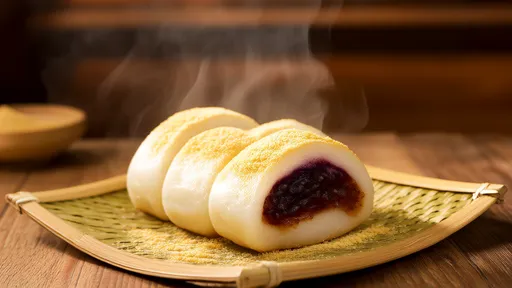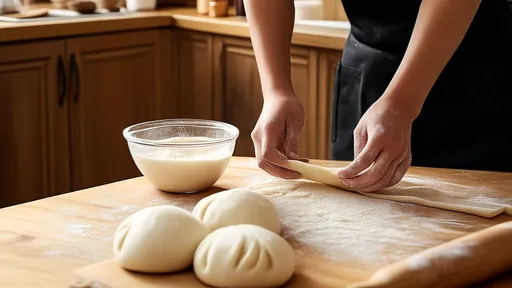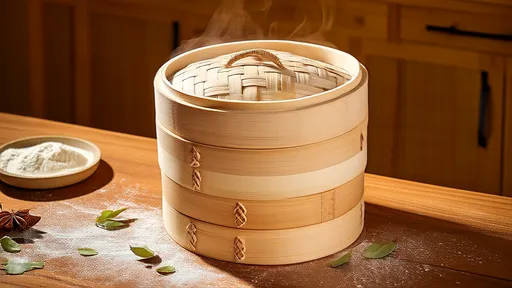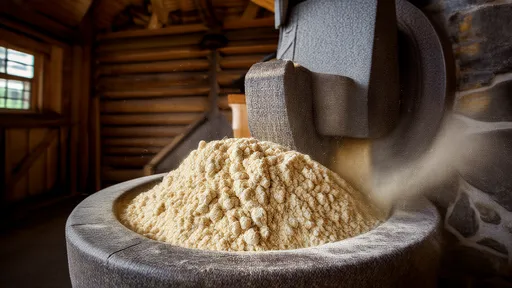The world of traditional fermented foods holds countless microbial secrets, and few are as fascinating as the complex ecosystem of laomian – the centuries-old sourdough starter that gives Chinese steamed bread its distinctive character. While modern bakeries increasingly rely on commercial yeast, artisanal producers across northern China still maintain their family laomian cultures like precious heirlooms, passing down not just techniques but living microbial communities through generations.
Recent breakthroughs in food microbiology have begun decoding how these wild microbial consortia create mantou's unique flavor profile. Unlike single-strain baker's yeast, laomian contains dynamic populations of lactic acid bacteria (LAB) and wild yeasts that engage in intricate metabolic dialogues. Researchers at Shandong University identified over 120 volatile organic compounds in laomian-fermented dough that never appear in commercial yeast preparations, including rare esters like ethyl 3-methylbutanoate that create fruity undertones.
The fermentation magic begins when Lactobacillus plantarum and Lactobacillus brevis strains start breaking down complex carbohydrates. These bacteria don't just produce lactic acid – they generate a cascade of precursor molecules that wild yeasts like Saccharomyces cerevisiae and Pichia kudriavzevii later transform into aromatic compounds. This microbial teamwork explains why laomian fermentation develops deeper flavors than any single microorganism could achieve alone.
Temperature plays a surprising role in shaping the flavor outcome. When maintained at 28-32°C, laomian cultures favor homofermentative LAB that produce clean lactic acid notes. But cooler temperatures around 22-25°C encourage heterofermentative strains that create additional flavor compounds like acetic acid, ethanol, and even small amounts of diacetyl – the compound responsible for buttery aromas in good champagne. This explains why winter mantou often develops more complex flavor profiles than summer batches.
The starch-protein matrix of wheat flour acts as both canvas and collaborator in this biochemical ballet. During fermentation, proteolytic enzymes from microbial activity gradually break down gluten proteins into amino acids that serve as flavor precursors. Meanwhile, amylase enzymes convert starch into maltose and glucose, which not only feed the microbial community but participate in Maillard reactions during steaming that create mantou's characteristic golden hue and nutty undertones.
Regional variations in laomian microbiota tell fascinating stories of microbial geography. Starters from Shanxi province show unusually high concentrations of Lactobacillus sanfranciscensis (despite the name, a common sourdough bacterium worldwide), which produces distinct malty notes. Shandong cultures often contain Torulaspora delbrueckii yeast strains that elevate floral ester production. These microbial fingerprints persist even when starters are transplanted, suggesting environmental factors like water chemistry and local wheat varieties help shape each community.
The time dimension adds another layer of complexity. Multi-year laomian cultures develop stable microbial ecosystems where different species occupy specific metabolic niches. Younger starters often produce sharper acidity as dominant LAB strains haven't yet established equilibrium with acid-tolerant yeasts. This explains why master fermenters prize their decades-old cultures – not just for sentiment, but for the refined balance of flavors that only emerges after years of microbial coevolution.
Modern analytical techniques have revealed how traditional maintenance practices scientifically benefit the culture. The customary practice of "feeding" the starter with fresh flour and water isn't just about providing nutrients – it creates periodic population bottlenecks that prevent any single microbe from dominating. This maintenance of diversity is crucial for flavor complexity. Similarly, the traditional clay storage pots used in rural households maintain ideal humidity and gas exchange conditions that plastic containers disrupt.
Emerging research suggests these microbial communities may offer benefits beyond flavor. Certain laomian strains produce gamma-aminobutyric acid (GABA), a neurotransmitter associated with relaxation. Others generate exopolysaccharides that may act as prebiotics. While these potential health aspects require further study, they hint at why traditional fermented foods often feel more satisfying than their industrial counterparts.
As scientists continue decoding laomian's microbial symphony, artisans face the challenge of preserving these living traditions in an age of industrial convenience. Some innovative producers are creating "microbial banks" to safeguard regional starter diversity, while others collaborate with scientists to optimize traditional methods without sacrificing microbial complexity. What emerges is a fascinating dialogue between ancient wisdom and modern science – all in pursuit of the perfect steamed bread.
The humble mantou, it turns out, is far more than simple steamed dough. Each bite contains the metabolic poetry of countless microorganisms, a living heritage of flavor shaped by generations of bakers and trillions of invisible collaborators. As we learn to listen to these microbial conversations, we gain not just better steamed bread, but deeper appreciation for the intricate biological wisdom embedded in traditional food cultures.
The art of baking a perfect cake relies heavily on understanding the science behind its structure. Among the many factors that contribute to a cake's texture, the uniformity of air pockets within the cake crumb stands out as a critical element. This characteristic is largely influenced by the foaming properties of proteins in the batter, particularly those found in eggs. The way proteins trap and stabilize air bubbles during mixing directly impacts the final product's lightness, tenderness, and overall mouthfeel.
The world of sensory evaluation is as intricate as it is fascinating, particularly when it comes to understanding how we perceive flavors and aromas. Among the myriad of compounds that contribute to our sensory experiences, vanillin—the primary component of vanilla extract—stands out for its widespread use and complex interaction with our senses. The concept of odor threshold plays a pivotal role in determining how much of this compound is needed for it to be detectable, and it varies significantly depending on the medium in which it is presented.
The world of chili peppers is as diverse as it is fiery, with each variety packing its own unique punch. At the heart of understanding this heat lies the Scoville Scale, a measurement that quantifies the spiciness of peppers. Developed by Wilbur Scoville in 1912, this scale remains the gold standard for gauging the capsaicin content—the compound responsible for that burning sensation—in different peppers. From the mild bell pepper to the mind-numbing Carolina Reaper, the Scoville Scale offers a fascinating glimpse into the spectrum of heat that chili enthusiasts chase.
The culinary world has long celebrated the magic that happens when certain ingredients come together, creating flavors greater than the sum of their parts. One such pairing—chicken broth and mushrooms—exemplifies the scientific and gastronomic phenomenon known as umami synergy. This dynamic duo has been a staple in kitchens across cultures, from French consommé to Japanese ramen, and its power lies in the way their compounds interact to amplify savory depth.
The world of fermented foods is a fascinating intersection of microbiology, chemistry, and culinary tradition. Among these, kimchi stands out not only for its bold flavors but also for the intricate biochemical processes that transform raw vegetables into a probiotic-rich delicacy. At the heart of this transformation lies a phenomenon known as acetic acid penetration, which creates a dynamic pH gradient during fermentation. This process is far more than a simple souring of cabbage—it's a carefully orchestrated dance between microbial communities and their chemical environment.
The turbidity of fruit juice, often perceived as a mark of freshness and natural quality, is primarily governed by the suspension mechanisms of pulp particles. These tiny fragments of fruit flesh, ranging from cellular debris to larger fibrous clusters, create the characteristic cloudiness that consumers associate with premium products. Behind this seemingly simple phenomenon lies a complex interplay of physical forces, biochemical interactions, and processing variables that determine whether pulp remains evenly dispersed or separates over time.
The fizz in your soda isn't just about taste—it's a carefully engineered dance between gas and liquid that begins unraveling the moment you twist open the cap. Few consumers realize how precisely carbonation levels are calibrated, or how dramatically pressure dynamics shift during that first explosive release. This invisible physics experiment in every bottle follows predictable but fascinating patterns that beverage scientists have spent decades mapping.
The world of espresso is as complex as it is captivating, with its rich flavors and aromatic allure. At the heart of this complexity lies a seemingly simple yet scientifically intricate component: the crema. This golden-brown layer of foam that crowns a well-pulled shot of espresso is not just a visual delight but a fascinating study in colloidal stability. The interplay of oils, gases, and solids in espresso crema reveals a delicate balance that defines the quality and texture of the coffee.
The phenomenon of "cold turbidity" or "cream down" in tea has long intrigued both tea connoisseurs and scientists alike. This natural occurrence, where tea liquor turns cloudy upon cooling, is not merely an aesthetic curiosity but a window into the complex chemistry of tea. Recent advancements in optical measurement techniques have enabled researchers to quantify this phenomenon through turbidity detection based on tea liquor transmittance, opening new avenues for quality assessment and understanding of tea's molecular interactions.
The world of instant noodles thrives on convenience, but behind that simplicity lies a carefully engineered marvel of food science. At the heart of this innovation sits pregelatinized starch—an unsung hero that transforms dehydrated noodles into a steaming bowl of comfort within minutes. Unlike traditional starch, pregelatinized starch undergoes a thermal and mechanical treatment that breaks down its granular structure, allowing it to absorb water rapidly. This property is pivotal for instant noodles, where rehydration speed and texture determine consumer satisfaction.
The world of traditional fermented foods holds countless microbial secrets, and few are as fascinating as the complex ecosystem of laomian – the centuries-old sourdough starter that gives Chinese steamed bread its distinctive character. While modern bakeries increasingly rely on commercial yeast, artisanal producers across northern China still maintain their family laomian cultures like precious heirlooms, passing down not just techniques but living microbial communities through generations.
The sticky, chewy texture of glutinous rice cakes, known as mochi in Japanese or nuòmǐ cí in Chinese, has long been a staple in East Asian cuisine. These delectable treats, often enjoyed during festivals or as everyday snacks, owe their unique consistency to a key component: amylopectin, the branched-chain starch found in glutinous rice. However, anyone who has left mochi or Chinese mochi cakes (糍粑) at room temperature for a few hours will notice an unmistakable transformation—the once-soft and pliable dessert gradually hardens, becoming tougher and less enjoyable. This phenomenon, often referred to as retrogradation, is a fascinating interplay of chemistry, physics, and culinary science.
The art of cooking perfect rice lies in understanding the gelatinization temperature of different japonica rice varieties. This scientific parameter, often overlooked by home cooks, determines the precise moment when starch granules absorb water and swell—fundamentally shaping texture, flavor release, and nutritional accessibility. Recent studies across Asian research institutions reveal how subtle genetic variations in short-grain rice cultivars create distinct thermal behaviors during cooking, challenging the one-size-fits-all approach to water ratios and heat application.
The art of crafting perfect hand-pulled noodles lies in mastering the delicate balance between gluten development and dough relaxation. Among the many variables that influence noodle extensibility, resting time stands as one of the most critical yet often overlooked factors. This silent alchemy occurring during the waiting period transforms a stiff, unyielding mass into an elastic, cooperative material ready to be stretched into silky strands.
For generations, home cooks and professional chefs alike have relied on stainless steel containers for pickling and food storage. The material's reputation for durability and corrosion resistance makes it a seemingly ideal choice. But when acidic ingredients like vinegar enter the equation, questions arise about potential metal leaching and food safety. Understanding the interaction between stainless steel and pickling brines requires a deeper dive into metallurgy, chemistry, and culinary science.
The bamboo steamer, a centuries-old culinary tool cherished across Asian kitchens, operates on principles far more sophisticated than its simple appearance suggests. Among its most fascinating phenomena is the so-called "bamboo steamer effect" – a self-regulating mechanism that prevents the dreaded condensation drip-back, ensuring perfectly textured dumplings, buns, and fish every time. This natural engineering marvel has captivated chefs and scientists alike, revealing how traditional wisdom often anticipates modern food science.
The age-old practice of stone milling has long been revered for its ability to produce flour that retains the natural goodness of whole grains. Unlike modern industrial milling methods, which often prioritize speed and shelf life, stone grinding operates at a slower pace, preserving the integrity of the grain’s nutritional profile. One of the most significant advantages of this traditional method is its ability to maintain higher levels of dietary fiber in whole wheat flour—a component essential for digestive health, blood sugar regulation, and overall well-being.
















